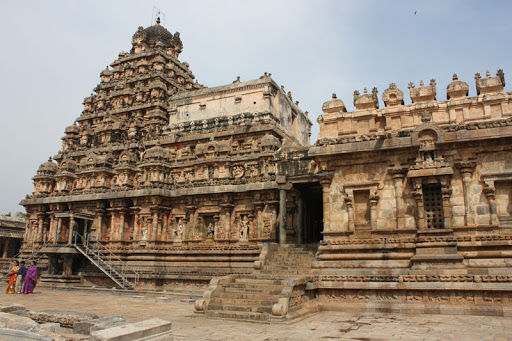- VedicFolks Exclusive Homam
- Spiritual Products
Standers 2
- VedicFolks Pooja
- Deity Idols & Statues
Standers 2
- Top Products

Airavataswara Temple is located in Kumbakonam, Tamilnadu. The temple is dedicated to Lord Shiva. The temple became built inside the chariot shape and built in sculpture, has smaller shrines committed to numerous Vedic and Puranic deities consisting of Indra, Agni, Varuna, Vayu, Lord Brahma, Lord Surya, Lord Vishnu, Saptamatrikas, Goddess Durga, Goddess Saraswati, Sri devi (Lakshmi), Ganga, Yamuna, Subrahmanya, Ganesha, Kama, Rati and others. Lord Shiva’s partner has a smaller shrine toward the northern side of the temple premises called Periya Nayaki Amman. currently, some of the temple is in a crumpled country with the gopurams absolutely in ruins. but, the principle shrine and the associated sanctums nevertheless stand sturdy. The temple draws pilgrims and devotees in thousands annually particularly during the month of Magha for numerous unique poojas.As in keeping with legacy, temple goes to say that Lord Shiva became worshipped by means of Airavat, Lord Indra’s white elephant. As in line with the mythology, Airavat became cursed by sage Durvasa for he disrespected the hermit. The curse went directly to discolor the pearly white skin of the elephant. Airavat got his color again by using taking a dip inside the water tank of this Lord Shiva’s Temple. this is how the temple were given its call. The water tank nevertheless rests here and pilgrims trust that through taking a holy dip inside the waters right here will cleanse them in their sins. This story is likewise carved in stone inside the inner chambers of the shrine.
Airavatesvara Temple is one of the four temples built by means of the Cholas totally on stone Vimanas. The complex is built on a rectangular plan; Nandi Mandap and the stampa are placed outside the shrine and are aligned with the temple’s east-west axis. The sanctum sanctorum has thick walls and the vimana superstructure rises exactly above the centre. The circumferencing course is however, no longer made around the sanctum like the different temples but alternatively it is out of doors, surrounding the courtyard.within the south-west corner of the court docket is a mandapam having 4 shrines. this sort of has an picture of Yama. adjoining this shrine are big stone slabs sculptured with images of the sapthamathas (seven celestial nymphs). the development of a separate temple for Devi, barely later than the main temple, suggests the emergence of the Amman shrine as an vital issue of the South Indian temple complex.